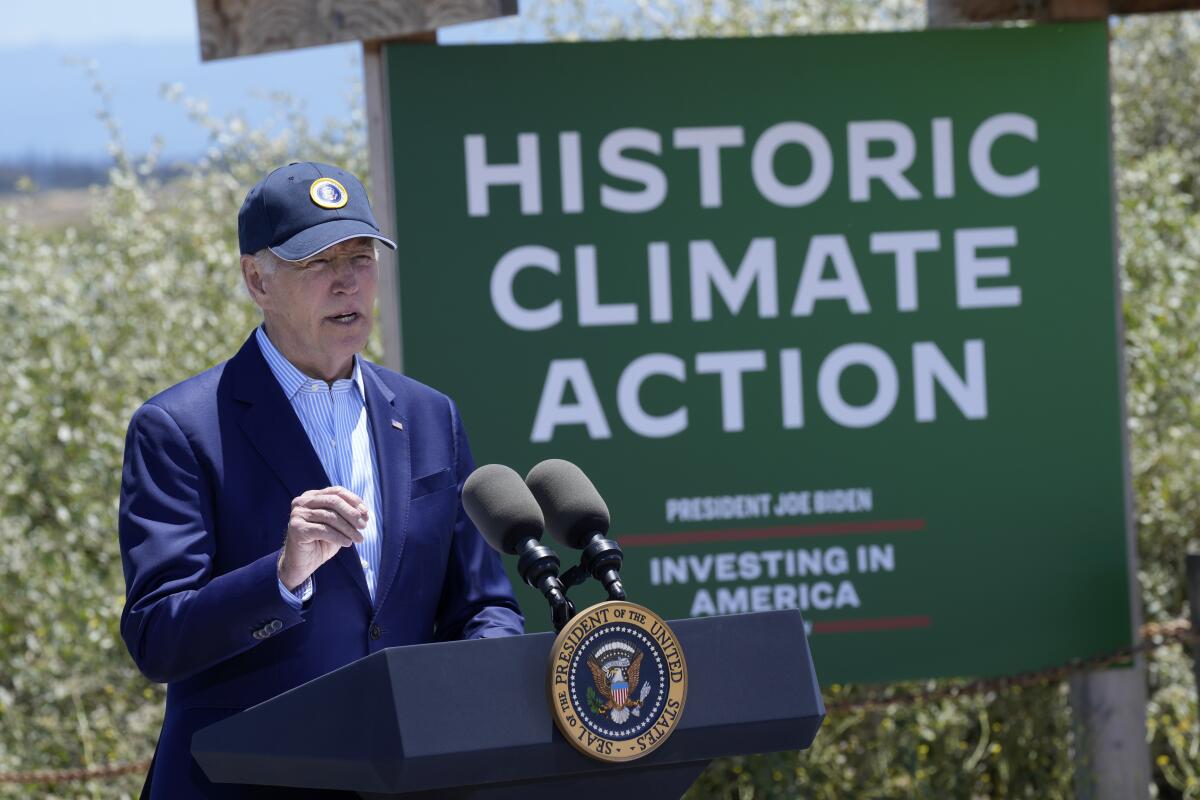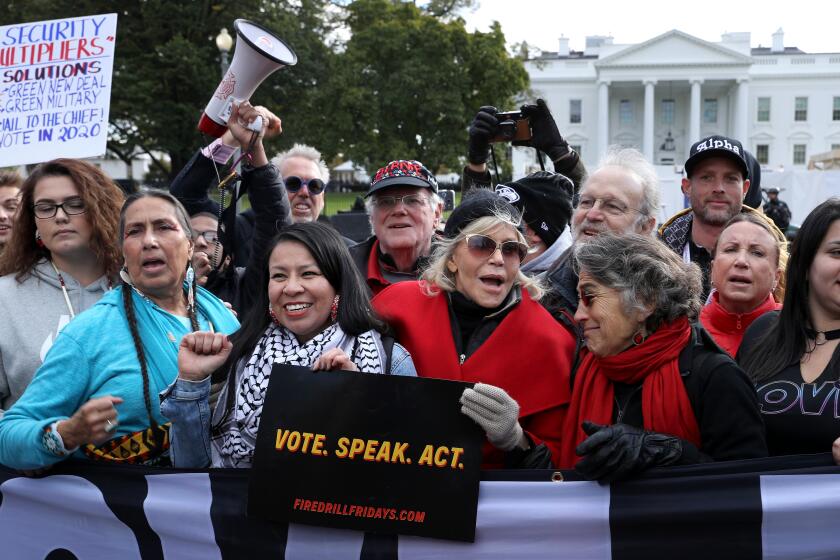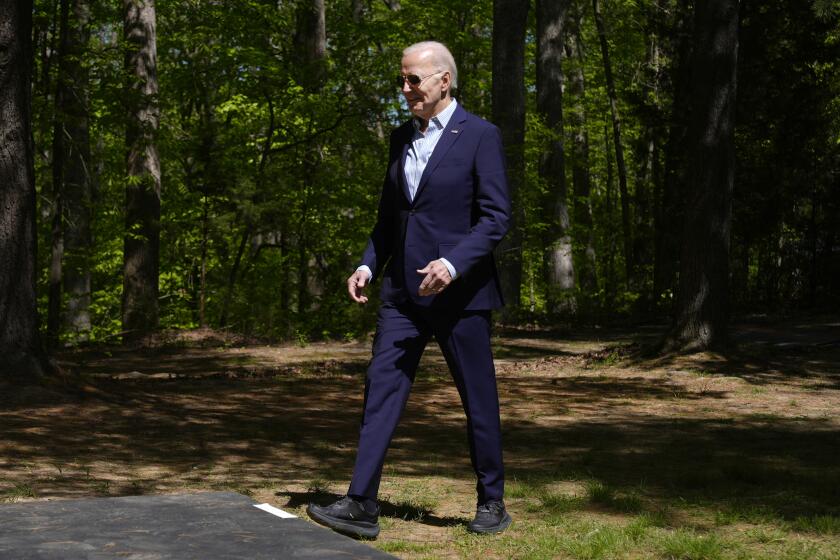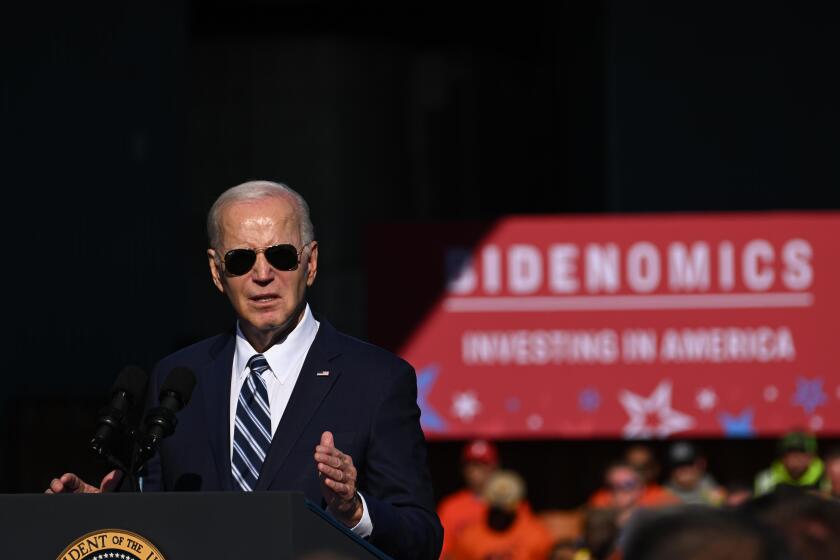As the election nears, Biden pushes a slew of rules on the environment and other priorities

- Share via
WASHINGTON — As he seeks to secure his legacy, President Biden has unleashed a flurry of rules this election year on the environment and other topics, including a landmark regulation that would force coal-fired power plants to capture smokestack emissions or shut down.
The limits on greenhouse gas emissions from fossil-fueled electric stations are the Democratic president’s most ambitious effort yet to roll back planet-warming pollution from the power sector, the nation’s second-largest contributor to climate change.
The power plant rule is among more than 60 regulations Biden’s administration finalized last month to meet his policy goals, including a promise to cut by 2030 roughly half of U.S. carbon emissions that drive climate change. The changes, led by the Environmental Protection Agency but involving a host of other federal agencies, are being issued in quick succession as the Biden administration rushes to meet a looming but uncertain deadline before there’s a new Congress — or a new president.
“The Biden administration is in green blitz mode,″ said Lena Moffitt, executive director of the activist group Evergreen Action.
It’s not just the environment
The barrage of rules cover more than the environment.
With the clock ticking toward election day, Biden’s administration has issued or proposed new rules on a wide range of issues — including student loan forgiveness, affordable housing, overtime pay, health and airline passenger delays — as he tries to woo voters in his reelection bid against presumptive Republican nominee Donald Trump.
Federal agencies broke records by publishing 66 significant final rules in April, more than any month in Biden’s presidency, according to George Washington University’s Regulatory Studies Center. More than half of the rules — 34 — were considered likely to have an economic impact of at least $200 million, the center said.
That tally is by far the highest issued by a recent president in a single month, the center said. The next highest was 20 such rules that former President Trump issued in his last month in office.
Biden is not shying away from promoting the rules. He went to Madison, Wis., for example, to speak about his actions for student loan relief after the Supreme Court rejected his initial plan. More often, Cabinet officials are being dispatched around the country, often to swing states, to promote the administration’s actions.
Want to stop global warming? Start thinking about Joe Biden and Donald Trump.
The problem with rules
Policies created by such rulemaking are easier to reverse than laws when a new administration takes office, especially with a sharply divided Congress.
“There’s no time to start like today,” Biden said on his first day in office in 2021 as he moved to dismantle the Trump legacy.
Over the course of his presidency, Biden has reinstated protections for threatened species that were rolled back by Trump. He also reversed the former president by boosting fuel efficiency standards.
The Education Department’s gainful employment rule targets college programs that leave graduates with high debt compared with their expected earnings. And the Department of Housing and Urban Development moved to restore a rule designed to eliminate racial disparities in suburbs, something Trump had thrown out.
It’s widely expected that Trump would move to reverse Biden’s regulations if he were to win in November.
Many young voters don’t know much about Biden’s climate record. And many activists who helped fuel his 2020 victory are angry about Gaza and a drilling project.
Deadlines are looming
The Congressional Review Act allows lawmakers to void new rules after they’re finalized by the executive branch. Congressional Republicans used the once-obscure law more than a dozen times in 2017 to undo actions by former President Obama. Democrats returned the favor four years later, rescinding three Trump administration rules.
Floor votes to void a rule must pass within 60 legislative days of its publication in the Federal Register, a deadline that shifts depending on how long Congress is in session.
Administration officials say they believe their actions so far this year will be shielded from voiding by the next Congress — although Republicans oppose nearly all of them and have filed challenges that could lead to a series of votes in the House and Senate over the next few months.
But Biden has the power to veto any such repeal effort that reaches his desk while he’s in the Oval Office.
“The rules are safe in this Congress,″ given Democratic control of the Senate and White House, said Michael Gerrard, who teaches environmental law at Columbia Law School. If Republicans take over Congress and the White House next year, ’’all bets are off,” Gerrard said.
Rulemaking for a legacy
In addition to the power plant regulation, the EPA has also issued rules targeting tailpipe emissions from cars and trucks and methane emissions from oil and gas drilling. The Interior Department, meanwhile, has restricted new oil and gas leases on 13 million acres of a federal petroleum reserve in Alaska, and now requires that oil and gas companies pay more to drill on federal lands and that they meet stronger requirements to clean up old or abandoned wells.
Industry groups and Republicans have slammed Biden’s actions as overreach.
“This barrage of new EPA rules ignores our nation’s ongoing electric reliability challenges and is the wrong approach at a critical time for our nation’s energy future,” said Jim Matheson, chief executive of the National Rural Electric Cooperative Assn.
The EPA has also finalized a long-delayed ban on asbestos, a carcinogen that kills tens of thousands of Americans every year, and has set strict limits on certain “forever chemicals″ in drinking water. The agency is also requiring more than 200 chemical plants nationwide to reduce toxic emissions that are likely to cause cancer, mostly in poor and minority communities already overburdened by industrial pollution.
Many of Biden’s actions have been planned since he took office, and have reinstated or strengthened more than 100 environmental regulations that Trump weakened or eliminated.
The rules come two years after Democrats approved a sweeping law aimed at boosting clean energy that is widely hailed as the most significant U.S. climate legislation ever enacted.
Democrats say the climate law and Biden’s executive actions could solidify his standing with climate-oriented voters — including young people who helped put him in office four years ago — and help him fend off Trump in November’s likely rematch.
“Every community in this country deserves to breathe clean air and drink clean water,’’ said EPA Administrator Michael S. Regan. “We promised to listen to folks that are suffering from pollution and act to protect them.’’
‘Challenging times’
Along with votes in Congress, the rules are expected to face legal challenges from multiple industries and Republican-led states; several lawsuits seeking to block them have already been filed.
“Part of our strategy is to be sure that we understand the current court culture that we’re in, and make sure that every action, every rule, every policy is more durable, as legally sound as possible,” Regan told a conference of environmental journalists last month.
Still, looming over all of the executive branch’s actions is the Supreme Court, where a 6-3 conservative majority has increasingly reined in the powers of federal agencies, including the EPA. A landmark 2022 ruling limited the EPA’s authority to regulate carbon dioxide emissions from power plants that contribute to global warming, and another ruling weakened regulations protecting millions of acres of wetlands.
A video on former President Trump’s social media site mentioned a ‘unified Reich’ under a second Trump term. Critics were quick to call it out.
One case pending before the justices could put the EPA’s “good neighbor” plan for fighting air pollution on hold while court challenges continue.
“We are living in challenging times in so many ways, but we at EPA are staying focused on the mission,’′ Regan said at the April conference. “And then we have to really just defend that case in court.’’
West Virginia Atty. Gen. Patrick Morrisey, who led the challenge in the 2022 Supreme Court case, said the EPA was adhering to what he called Biden’s “Green New Deal’’ agenda.
“Unelected bureaucrats continue their pursuit to legislate rather than rely on elected members of Congress for guidance,” said Morrisey, the GOP nominee for governor in the state.
Rules issued by other agencies also face legal challenges. Republican-led states are challenging new Title IX rules that provide expanded protections for LGBTQ+ students and new safeguards for victims of sexual assault. They’re also suing to overturn a rule requiring background checks to buy firearms outside stores, including at gun shows.
The former president leads President Biden in six of seven battleground states. The two are tied in Wisconsin.
Gerrard, the Columbia law professor, said the threat of executive branch actions being overturned by Congress or the courts “makes it hard for either side to build up any momentum.’’ That uncertainty also affects industries’ compliance, since they don’t how long a rule will be in effect.
‘Staying power on climate’
Gerrard and other experts said the climate and bipartisan infrastructure laws passed in 2021 are more durable and will be harder for a future president to unwind. Combined with executive branch actions, the laws will put the country on a path to meet Biden’s goal of net-zero carbon emissions by 2050, environmentalists say.
The climate law, which includes nearly $400 billion in spending to boost clean energy, will have ripple effects on the economy for years to come, said Christy Goldfuss, executive director of the Natural Resources Defense Council and a former Obama administration official.
She pushed back on complaints by industry and Republicans that the power plant rule is a continuation of an Obama-era “war on coal.″
“It’s an attack on pollution,″ she said.
Daly writes for the Associated Press.
More to Read
Sign up for Essential California
The most important California stories and recommendations in your inbox every morning.
You may occasionally receive promotional content from the Los Angeles Times.














